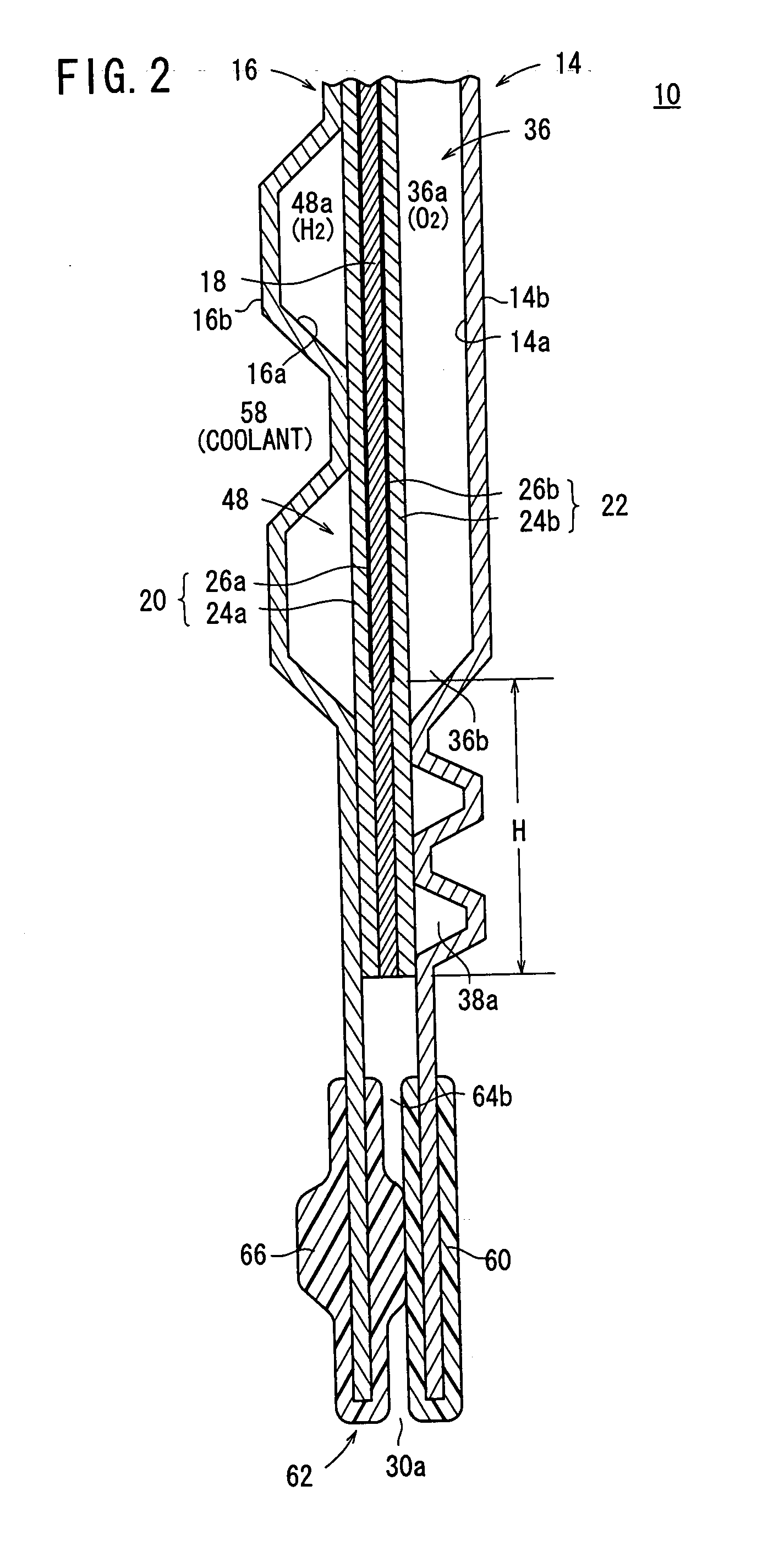Fuel cell
a fuel cell and fuel gas technology, applied in the field of fuel cells, can solve the problems of affecting the performance of power generation, affecting the efficiency of power generation, and affecting the electrode catalysts of the electrolyte electrode assembly, and achieve the effect of simple structure, smooth and reliable discharge of retained water
- Summary
- Abstract
- Description
- Claims
- Application Information
AI Technical Summary
Benefits of technology
Problems solved by technology
Method used
Image
Examples
first embodiment
[0045]FIG. 1 is an exploded perspective view showing main components of a fuel cell 10 according to the present invention. A membrane electrode assembly (electrolyte electrode assembly) 12 and first and second metal separators 14, 16 are stacked together in a horizontal direction indicated by an arrow A. In general, a plurality of fuel cells 10 are stacked together to form a fuel cell stack.
[0046] The membrane electrode assembly 12 includes an anode 20, a cathode 22, and a solid polymer electrolyte membrane 18 interposed between the anode 20 and the cathode 22. The solid polymer electrolyte membrane 18 is formed by impregnating a thin membrane of perfluorosulfonic acid with water, for example.
[0047] As shown in FIG. 2, each of the anode 20 and the cathode 22 has a gas diffusion layer 24a, 24b such as a carbon paper, and an electrode catalyst layer 26a, 26b of platinum alloy supported on porous carbon particles. The carbon particles are deposited uniformly on the surface of the gas ...
third embodiment
[0076]FIG. 6 is a front view showing a first metal separator 90 of a fuel cell according to the present invention.
[0077] The first metal separator 90 has an oxygen-containing gas flow field (reactant gas flow field) 92 comprising a plurality of oxygen-containing gas flow grooves 92a in a serpentine pattern. At ends 92b, 92c of the oxygen-containing gas flow grooves 92a, every two grooves are merged such that one of the two grooves is curved, and the merged grooves are connected to the inlet buffer 50a and the outlet buffer 50b. Because the ends 92b, 92c are extended outwardly from the electrode catalyst layers 26a, 26b by the distance L, the flow rate of the purging air is not decreased. In the structure, the same advantages as in the case of the first and second embodiments can be obtained. For example, the retained water can be discharged from the electrode catalyst layers 26a, 26b smoothly and reliably.
fourth embodiment
[0078]FIG. 7 is a front view showing a first metal separator 100 according to the present invention. The first metal separator 100 has an oxygen-containing gas flow field (reactant gas flow field) 102 comprising a plurality of oxygen-containing gas flow grooves 102a in a serpentine pattern. Ends 102b, 102c of the oxygen-containing gas flow grooves 102a are extended outwardly from the electrode catalyst layers 26a, 26b by the distance L toward an inlet buffer 104a and an outlet buffer 104b.
[0079] A plurality of bosses 106a, 106b are formed in the inlet buffer 104a and the outlet buffer 104b. The distance S1 between the ends 102b, 102c of the oxygen-containing gas flow grooves 102a and the nearest bosses 106a, 106c is substantially the same as the distance S2 of the groove width of the oxygen-containing gas flow grooves 102a.
[0080] In the fourth embodiment, when the purging air is supplied to the oxygen-containing gas flow grooves 102a of the oxygen-containing gas flow field 102 at ...
PUM
| Property | Measurement | Unit |
|---|---|---|
| distance | aaaaa | aaaaa |
| distance | aaaaa | aaaaa |
| distance | aaaaa | aaaaa |
Abstract
Description
Claims
Application Information
 Login to View More
Login to View More - R&D
- Intellectual Property
- Life Sciences
- Materials
- Tech Scout
- Unparalleled Data Quality
- Higher Quality Content
- 60% Fewer Hallucinations
Browse by: Latest US Patents, China's latest patents, Technical Efficacy Thesaurus, Application Domain, Technology Topic, Popular Technical Reports.
© 2025 PatSnap. All rights reserved.Legal|Privacy policy|Modern Slavery Act Transparency Statement|Sitemap|About US| Contact US: help@patsnap.com



